US durable goods orders rose 15.8% mom to USD 194.4B in May, well above expectation of 10.3% mom. Ex-transport orders rose 4.0% mom, above expectation of 2.8% mom. Ex-defense orders rose 1.5.5%. Transportation equipment rose 80.7%.
US initial jobless claims dropped to 1.48m, continuing claims at 19.5m
US initial jobless claims dropped -60k to 1480k in the week ending June 20, above expectation of 1300k. Four-week moving average of initial claims dropped -160.75k to 1621k.
Continuing claims dropped to 767k to 19522k in the week ending June 13. Four-week moving average of continuing claims dropped -330k to 20421k.
ECB stand ready to adjust all instruments including PEPP, TLTROs, interest rates and forward guidance
In the accounts of June 3-4 ECB monetary policy meeting it’s noted there was “broad agreement” among Governing Council member to reiterate that the central bank “continued to stand ready to adjust all of its instruments, as appropriate”. This include further adjusting the size and composition of the PEPP, as well as the full range of instruments including the TLTROs, policy interest rates and forward guidance.
Governing Council members underlined that the sharp of economy recovery would “depend crucially on how consumption and investment evolved under the present uncertainties.” That also depends on whether the coronavirus pandemic leads to “longer-lasting changes in the behaviour of economic agents”.
In particular, he expected pattern of the “saving ratio” was seen as a “key issue”. Some concerns was expressed that “expecting a full unwinding of higher savings might be too optimistic, as protracted uncertainty might keep the ratio higher for longer”.
UK CBI realized sales rose to -37, slower pace of decline
UK CBI Realized Sales rose to -37 in June, up from -50, worst than expectation of -35, indicating the retail sales dropped at a slower pace. Decline for July is expected to be even worse at -48.
Rain Newton-Smith, CBI Chief Economist, said:
“With high street shops, department stores and shopping centres re-opening across England last week amid some scenes of long queues, you’d be forgiven for thinking retailers’ difficulties are coming to an end. But the health of the retail sector remains in the balance.
“Despite retailers working flat out to make sure they are safe and ready to open their doors, outside the grocery sector most retailers expect sales to be far below where they were this time last year.
“Enabling these businesses to open is a critical step on the road to restarting our economy and will help support hundreds of thousands of jobs across the UK.”
German Gfk consumer sentiment rose to -9.6, faint light getting somewhat brighter
Germany Gfk Consumer Sentiment for July rose to -9.6, up from -18.6, beat expectation of -11.0. Economic expectations rebounded strongly to 8.5, up from -10.4, back in positive territory. Income expectations also turned positive to 6.6., up from -5.7.
“The faint light at the end of the tunnel, which was already apparent last month, is apparently getting somewhat brighter,” explains Rolf Bürkl, GfK consumer expert. “The extensive support provided by the economic stimulus packages, such as the announcement of a temporary reduction in value-added tax (VAT), is certainly a contributing factor. Provided that retailers and manufacturers also pass these reductions on to consumers, it can be assumed that one or two planned purchases will instead be made in the second half of 2020, thereby supporting consumption this year.”
DOW dropped -710pts as near term consolidations extend
DOW dropped -710.16 pts, or -2.72%, overnight on worries of resurgence of coronavirus infections and transatlantic trade war. The technically development was not surprising though as the index remains bounded in consolidation from 27580.21 short term top. 55 day EMA (now at 25177) will be the first line of defense. But the key near term support level will be 38.2% retracement of 18213.65 to 27580.21 at 24002.18.
As long as 24002.18 holds, we’d still expect the rise from 18213.63 to resume sooner or later to retest 29568.57 record high. However, sustained break of 24002.18 will argue that consolidation pattern from 29568.57 is starting the third leg. Deeper fall would be seen to 61.8% retracement at 21791.67 and below.
New Zealand trade surplus down slightly to NZD 1253m
In May, New Zealand goods exports dropped -6.1% yoy, or NZD -350m to NZD 5.4B. Imports dropped -25.6% yoy, or NZD -1.4B, to NZD -4.1B. Trade surplus shrank slightly to NZD 1253m, down from NZD 1339m.
Looking at the details, exports to all major partners except Japan (unchanged), were down, including EU (NZD -95m), US (NZD -87m), China (NZD -77m), Australia (NZD – 72m). Imports from all partners, except China (up NZD 1.9m), were also down, including EU (NZD -231m), Japan (NZD – 223m), USA (NZD – 172m), Australia (NZD -108m).
EU: US tariffs inflict unnecessary economic damage on both sides of the Atlantic
In response to new tariff intention of the US, EU warned in a statement that “it creates uncertainty for companies and inflicts unnecessary economic damage on both sides of the Atlantic.”
“By potentially targeting new products, the US is increasing this damaging impact due to the cost of new disruptions to supply chains for the products potentially subject to new duties.” “This is particularly the case as companies are now trying to overcome the economic difficulties in the aftermath of the Covid-19 crisis.”
USTR announced earlier this week a list of 30 product lines that could be subjected to new tariffs. The news items, equivalent to around USD 3.1B of imports from EU annually, could be hit will tariffs of as much as 100%.
Fed Evans: Some previously expected trend growth has been permanently lost
Chicago Fed President Charles Evans said in a speech yesterday that real GDP would return to pre-pandemic level sometime in 2022. That is, “even after three years, my projected recovery places us below where the economy would have been had the virus not occurred”. Additionally, “some previously expected trend growth has been permanently lost.”
Also, despite the surprised job growth in May and recent positive economic data, it is too early to tell “how much of the improvement is simply timing” and “how much represents stronger underlying demand”. The outlook is highly uncertain and “other forecasts with more severe effects on economic activity are almost equally as plausible”. Regarding inflation, “some of the extreme price declines in March and April are likely behind us”. Besides, he expects “downward pressure on prices from resource slack to diminish in 2021 and 2022”.
Overall, while fiscal and monetary policy actions have already done a lot “more may be necessary.”
IMF expects deeper 2020 recession, slower 2021 recovery
In the new World Economic Update released today, IMF said it’s now projecting a deeper recession in 2020 and a slower recovery in 2021. It also noted that a high degree of uncertainty surrounds this forecast, with both upside and downside risks to the outlook. Upside risks include better news on coronavirus vaccines and treatments and additional policy support. Downside risks include deforceor waves of infections. Additionally, geopolitical and trade tensions could damage fragile global relationships.
In short, world output is projected to contract -4.9% in 2020 (revised down by -1.9%) and grow 5.4% in 20201 (revised down by -0.4%. For advanced economies, Eurozone, France, Italy, Spain, and UK are all expected to have double-digit contraction in GDP in 2021. None of the advanced economies are expected to fully recover the contraction in 2021.
US oil inventories rose 1.4m, WTI corrects lower
US commercial crude oil inventories rose 1.4m barrels in the week ending June 19, slightly above expectation of 1.2m barr3els. At 540.7m barrels, oil inventories are about 16% above the five year average for this time of the year. Motor gasoline inventories dropped -1.7m barrels. Distillate fuel inventories rose 0.25m barrels. Propane/propylene inventories rose 2.4m barrels.
XTI/USD edged higher to 41.39 earlier this week but dips notably after the release. Considering bearish divergence condition in 4 hour MACD, we’d continue to expect strong resistance from 42.05 to limit upside to bring a near term correction. That is, upside potential in WTI should be limited even in case of another rally. On the downside, break of 37.12 minor support should indicate short term topping and bring deeper fall to 55 day EMA (now at 34.07) and below.
German Ifo business climate rose to 86.2, business sees light at the end of the tunnel
Germany Ifo Business Climate rose to 86.2, up from 79.7, above expectation of 85.0. The 6.5 pts rise is the strongest increase ever recorded. Current Assessment index rose to 81.3, up from 78.9, but missed expectation of 84.0. Expectations index rose to 91.4, up from 80.5, above expectation of 85.2. Ifo said, “German business sees light at the end of the tunnel.”
Indices of all sectors improved but stayed negative. Manufacturing index rose from -36.0 to -22.9. Services index rose fro -21.0 to -6.0. Trade index rose from -30.5 to -14.2. Construction index rose from -12.3 to -7.5.
ECB Lane: Net impact of coronavirus shock to be disinflationary to a substantial degree
In a speech, ECB Chief Economist Philip Lane said as coronavirus containment measures lifted, there were “some signs of an initial recovery”. But this process is expected to be “quite gradual”, since it will “take time for consumers and businesses to recover” from the coronavirus shock. Incomes losses and precautionary savings “continue to weigh on consumption”. Weak demand, continued supply constraints and ongoing social-distancing restrictions are “hampering the normalization of economic activity”.
He added that the net impact of the coronavirus shock on medium-term inflation outlook is expected to be “disinflationary to a substantial degree”. “Forces associated with greater economic slack are likely to outweigh any inflationary pressures stemming from damage to supply capacity”. The sharp drop in activity and fall in oil prices has “already left its mark” on Eurozone inflation.
On monetary policy tools, Lane said long term sovereign yields become “virtually unresponsive to rate cuts in stressed conditions owing to the subdued portfolio rebalancing effects”. Rate cuts are “unlikely to be as effective at the current juncture as they are in non-stressed conditions” . Policy that “directly intervene on sovereign yields may in fact become more effective. Hence, “evidence tilts the balance towards asset purchases as the more efficient tool in current circumstances.”
BoJ: Desirable to confirm and examine the effects of adopted easing measures for now
In the summary of opinions of BoJ’s June 15-16 meeting, it’s noted that the economy is “likely to remain in a severe situation for the time being” due to coronavirus pandemic. But the economy “recently appears to have bottomed out. But the “pace of economic recovery will likely be slow”. regarding prices, it’s “unlikely at present that the inflation rate will approach 2 percent with momentum in the foreseeable future”.
It’s also noted that the current three monetary easing measures, the financing program, provision of yen and foreign currency funds, and asset purchases, are “flexible” and “highly adaptable” to various developments. The measures adopted since March “have been exerting their intended effects”. It’s “desirable to carefully confirm and examine their effects for the time being”.
NZD falls after dovish RBNZ hints on additional easing
New Zealand Dollar weakens broadly after RBNZ kept policy unchanged and issued a dovish statement, which hinted at further easing ahead. OCR was kept at 0.25% while quantum of the LSAP QE program was held at NZD 60B. In the discussions of the board meeting, the committee acknowledged the “improvements” in the outlook as the country has moved to coronavirus Alert Level 1 sooner than assumed. The government’s spending intentions was also larger than assumed and would provide more spending support than previously estimated.
However, members were concerned that the “positives could be short-lived given the fragile nature of the global pandemic containment”. It’s “not yet clear whether the monetary stimulus delivered to date is sufficient” and risks remain “skewed to the downside”. More importantly, members discussed the pros and cons of “expanding” the LSAP program, which would be driven by the outlook. A change in asset purchase size needs to be of “sufficient magnitude”. Staff are also “working towards ensuring a broader range of monetary policy tools would be deployable in coming months, including a term lending facility, reductions in the OCR, and foreign asset purchases, as well as reassessing the appropriate quantum of the current LSAP.”
NZD/JPY dips notably after the release Current development suggests that price actions from 68.19 are merely a consolidation pattern, which could have completed at 69.66. Immediate focus is back on this 68.19 support. Break will extend the fall from 71.66.
The decline from 71.66 is seen as a correction to the rebound form 59.49. It could dip into the 66.16/37.01 target zone (100% projection of 71.66 to 68.19 from 69.66 at 66.16, 38.2% retracement of 59.49 to 71.66 at 67.01) before completion.
Gold breaches key resistance, resuming up trend?
Gold’s rally today suggests that larger up trend is possibly resuming. Sustained trading above 1765.25 resistance will confirm and pave they way to 61.8% projection of 1451.16 to 1765.25 from 1670.66 at 1864.76. However, break of 1747.31 minor support will suggest rejection by 1765.25 resistance. In this case, consolidation pattern from 1765.25 could extend with another falling leg before completion.
US PMI composite rose to 46.8, continual vigilance by the Fed, US Treasury and health authorities still required
US PMI Manufacturing rose to 49.6 in June, up from 39.8, missed expectation of 50.0. PMI Services rose to 46.7, up from 37.5, missed expectation of 46.9. PMI Composite rose to 46.8, up form 37.0. All three indices are at their 4-month high.
Chris Williamson, Chief Business Economist at IHS Markit, said:
“The flash PMI data showed the US economic downturn abating markedly in June. The second quarter started with an alarming rate of collapse but output and jobs are now falling at far more modest rates in both the manufacturing and service sectors. The improvement will fuel hopes that the economy can return to growth in the third quarter.
“However, although brief, the downturn has been fiercer than anything seen previously, leaving a deep scar which will take a long time to heal. We anticipate that the US economy will contract by just over 8% in 2020. The coming months will therefore see the focus turn to just how much recovery momentum the economy can muster to recoup this lost output.
“Any return to growth will be prone to losing momentum due to persistent weak demand for many goods and services, linked in turn to ongoing social distancing, high unemployment and uncertainty about the outlook, curbing spending by businesses and households. The recovery could also be derailed by new waves of virus infections. Continual vigilance by the Fed, US Treasury and health authorities will therefore be required to keep any recovery on track.”
UK PMIs: Return to growth in Q3, but longer term recovery prospects highly uncertain
UK PMI Manufacturing rose to 50.1 in June, up from 40.7, beat expectation of 45.3. The reading is a four-month high, and back in expansion. PMI Services rose to 47.0, up from 29.0, above expectation of 39.4, also a four-month high. PMI Composite rose to 47.6, up from 30.0, a four-month high too.
Chris Williamson, Chief Business Economist at IHS Markit, said:
“June’s PMI data add to signs that the economy looks likely return to growth in the third quarter… However, … the longer term recovery prospects remain highly uncertain…. Uncertainty over recovery prospects and job prospects also mean demand for many goods, especially non-essential big-ticket items, is likely to remain weak for many months, with Brexit uncertainty also continuing to cast a shadow over the economy.
“Our forecasting team therefore expects the economy to contract by 11.9% this year before expanding by a relatively modest 4.9% in 2021, which is far more cautious than the 15% surge anticipated in 2021 by the Bank of England.”
Eurozone PMI composite rose to 47.5, lifting of lockdown to bring downturn to an end into summer
Eurozone PMI Manufacturing rose to 48.9 in June, up from 39.4, above expectation of 43.8. PMI Services rose to 47.3, up from 30.5, above expectation of 40.5. PMI Composite rose to 47.5, up from 31.9, hitting at 4-month high but stayed in contraction.
Chris Williamson, Chief Business Economist at IHS Markit said: “The flash eurozone PMI indicated another substantial easing of the region’s downturn in June… While second quarter GDP is still likely to have dropped at an unprecedented rate, the rise in the PMI adds to expectations that the lifting of lockdown restrictions will help bring the downturn to an end as we head into the summer… However, with the timing of a return to normal still something that can only be speculated upon, and virus-related restrictions likely to continue to hit many businesses for the rest of the year, we remain very cautious of the strength and sustainability of any economic rebound.”




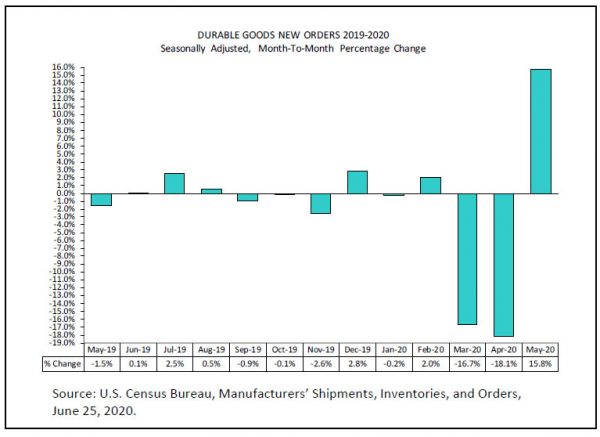
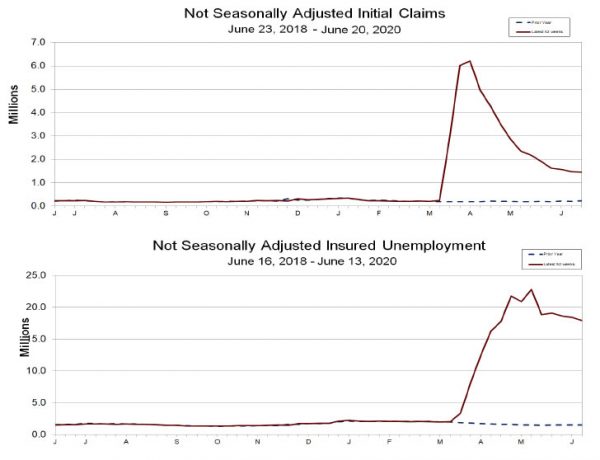

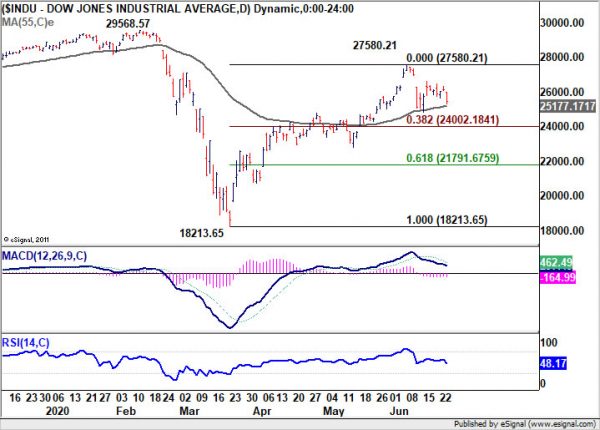
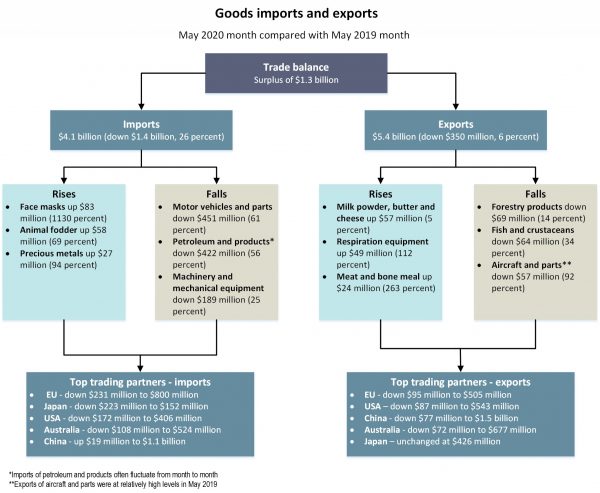
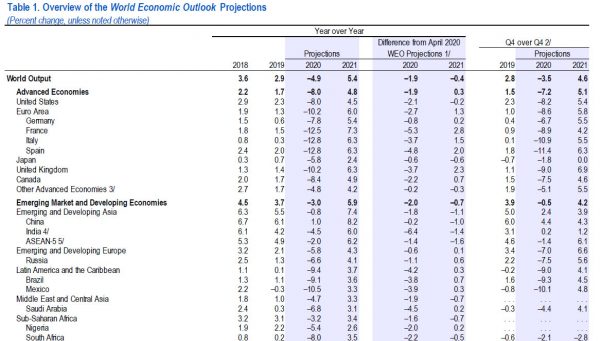
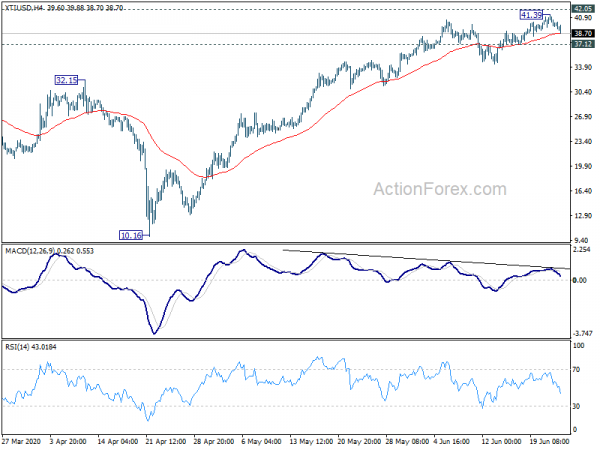
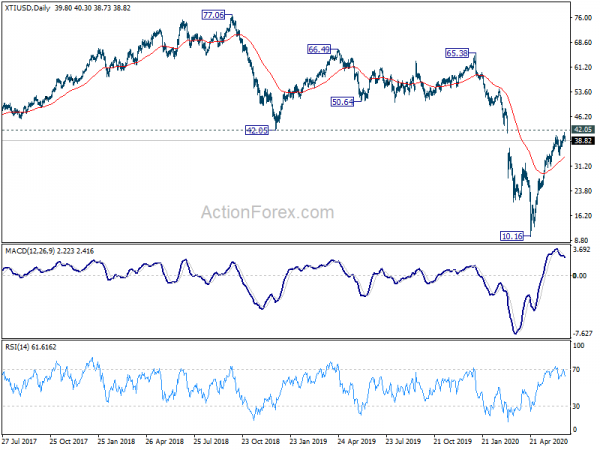

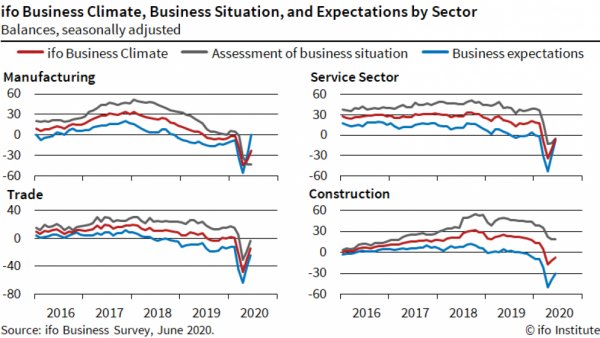
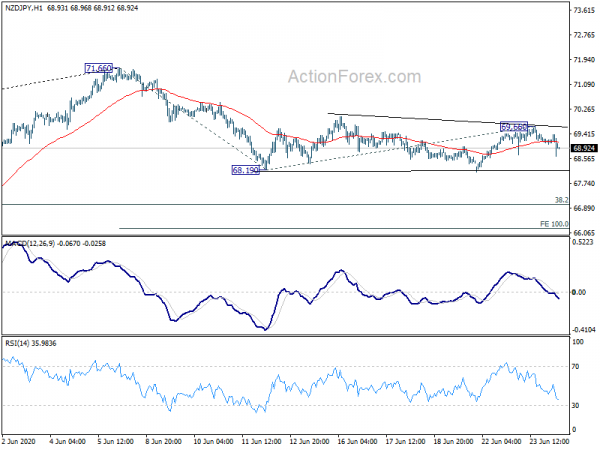
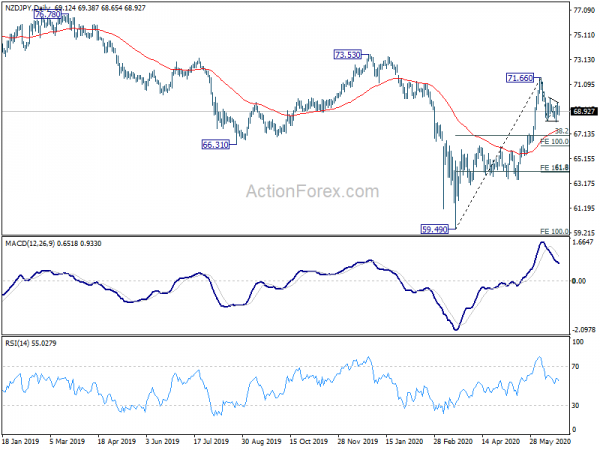



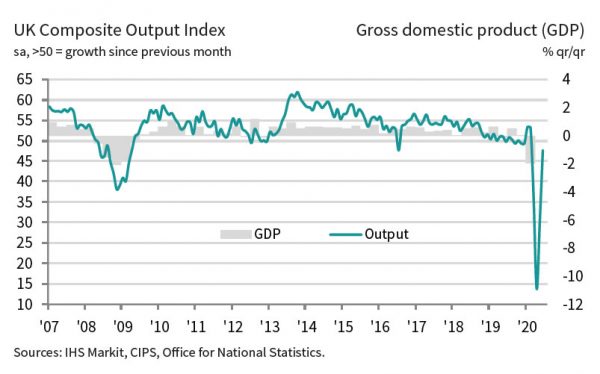
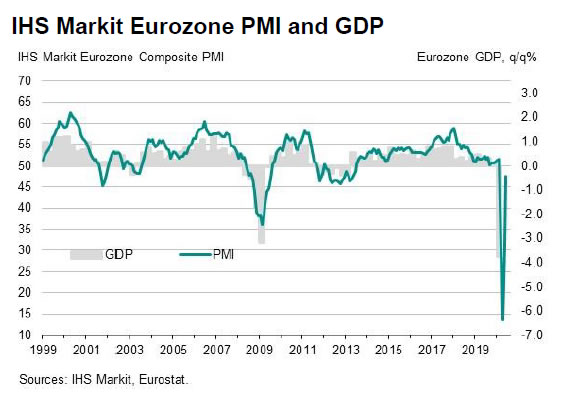

ECB Knot: Recent data solidified the confidence in our baseline scenario
ECB Governing Council member Klass Knot said today that recent positive economic data confirmed that a recovery is on the way. He said “recent data solidified the confidence in our baseline scenario”. However, “even in that baseline scenario, economic activity will only approach the pre-Corona 2019 level by the end of our projection horizon, at the end of 2022.”
Separately, Executive Board member Yves Mersch said “we would not need to make use of the full PEPP envelope if the governing council were to assess that market tensions had eased sufficiently.””We are mindful that the size of our balance sheet. The significant stock of acquired assets and reinvestments of the maturing principal payments can have implications for market functioning and price formation,” he added. “The sheer size of the PEPP also goes beyond its primary backstop function by providing additional support to the monetary policy stance.”